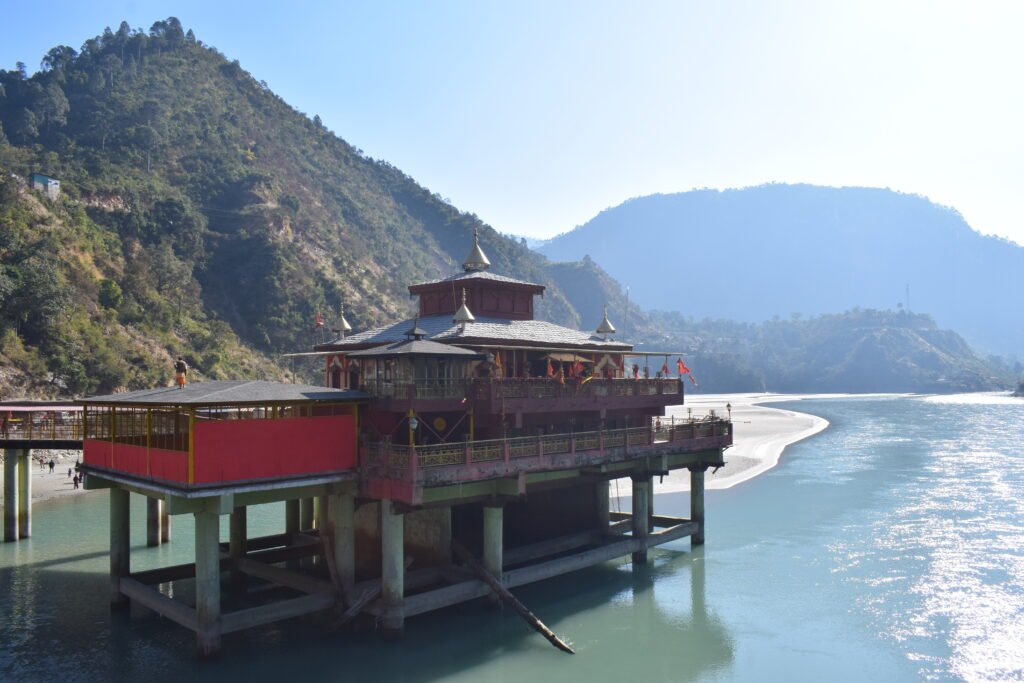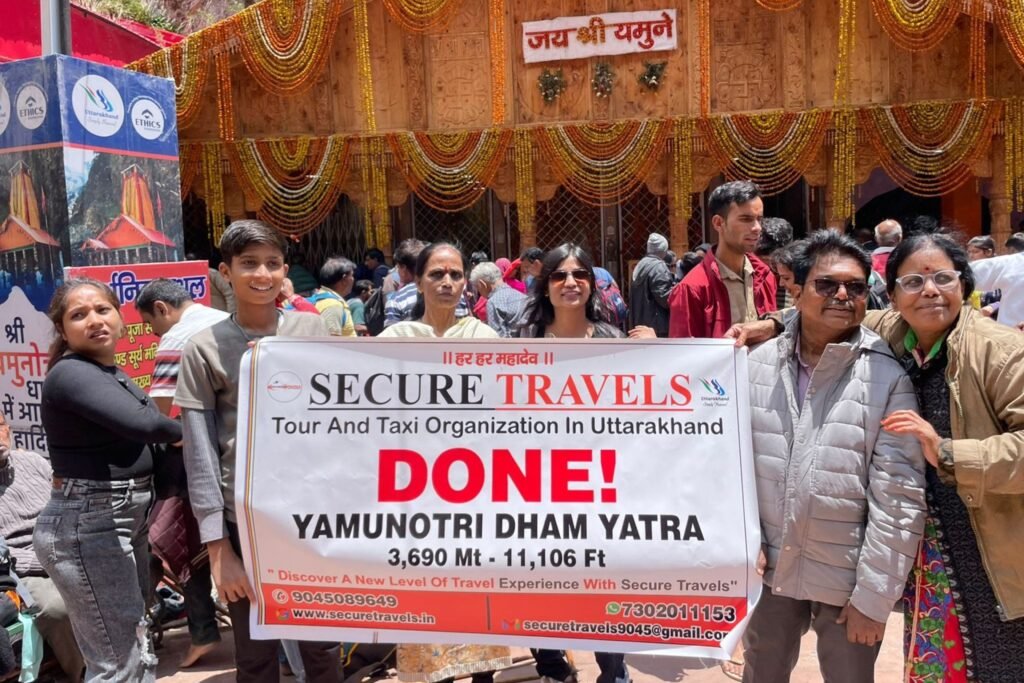Gangotri Dham

Gangotri Dham: A Spiritual Journey to the Origin of the Ganges Gangotri Dham is one of India’s most sacred pilgrimage areas, worshiped by millions of Hindus. It is the origin of the holy river Ganga, which is considered India’s lifeline. Gangotri Dham, founded in the picturesque state of Uttarakhand, is covered by the majestic Himalayas, and delivers breathtaking views and a religious the atmosphere. This blog will help you through the history, significance, nearest attractions, structures, beauty, and the best time to visit Gangotri Dham. History of Gangotri Dham Gangotri Dham has a long tradition and religious significance. According to Hindu mythology, Goddess Ganga descended from heaven to Earth at Gangotri Dham. in Hindu history, King Bhagirath meditated deeply in order to bring Ganga to Earth to cleanse his ancestors’ souls. Lord Shiva was very happy with his devotion and helped keep Ganga in his tangles in to contain her vast flow before releasing her at Gangotri Dham. This historical site has been an area of prayer for centuries attracting those who follow seeking spiritual peace. Amar Singh Thapa, a Gorkha chieftain, established the present-day Gangotri Temple in the early 18th century. Over the years, the temple has been preserved and reactivated, making it an attractive pilgrimage destination in Gangotri Dham. Why Do People Visit Gangotri Dham Religious Significance – Gangotri Dham is the birthplace of the the Ganga Hinduism’s holy river. Pilgrims visit to pay their respects and dip in the river to purify their souls.Many devotees journey on the Char Dham Yatra, which combines Gangotri, Yamunotri, Kedarnath, and Badrinath, in order to cultivate moksha.Peace and Serenity – Gangotri Dham’s pristine surroundings and divine the surroundings support spiritual development and peace.Adventure & Trekking – The region nearby Gangotri Dham has attractive trekking routes, making it an attraction for nature lovers and trekkers. Nearby Places to Visit Apart from the Gangotri Temple, various neighboring sites make Gangotri Dham a must-see destination: Gomukh Glacier – The genuine source of the Ganga River, approximately 18 kilometers from Gangotri Dham. It’s a popular trekking spot. Bhojbasa – A tranquil camping place on the road to Gomukh with breathtaking views of the Bhagirathi ranges. Tapovan – A high-altitude meadow with breathtaking vistas and spiritual importance. Surya Kund and Gauri Kund – Beautiful waterfalls and natural hot springs near Gangotri Dham where pilgrims take spiritual baths. Harsil – A beautiful valley around 25 kilometers from Gangotri Dham, ideal for wildlife enthusiasts. Dharali is a lovely town near Gangotri Dham known for its apple orchards and picturesque beauty The beauty of Gangotri Dham is unrivaled A beautiful landscape is created by mountains covered in snow, verdant valleys, cascading waterfalls, and the serene Bhagirathi River. It is the perfect place for meditation and introspection because of the calm surrounding and spiritual the aura. The river’s sound contributes tranquil soundscape to the placid atmosphere and the air is clear and fresh. Because of the severe snowfall, Gangotri Dham is closed throughout the winter. When is the ideal time to go to Gangotri Dham? Best Time to Visit Gangotri Dham The pleasant summer days of May to June are perfect for trekking and temple visits.The greenery is at its best after the monsoon months (July to September), but there is a risk of landslides.The best weather comes in the beginning of autumn (September to October) before the temple closes for the winter.The temple shuts and the area is inaccessible around the cold months of winter of November through April, so avoid going during those times. Quality and Facilities at Gangotri Dham The government and religious organizations of Uttarakhand take excellent care of the Gangotri Dham Temple. Facilities include of: The hotels for pilgrims visiting Gangotri Dham including hotels, ashrams, and guesthouses. Food: Local dhabas and ashrams serve simple vegetarian meals. Medical Facilities: Gangotri Dham has basic medical facilities, although it is important to bring your own prescriptions. Travel: Gangotri Dham is connected to nearby cities like Rishikesh and Dehradun by buses, taxis, and shared jeeps. Conclusion-: Gangotri Dham is an experience that combines adventure, nature, and spirituality; it is more than just a place of pilgrimage. Gangotri Dham gives something for everyone, whether your aim is to see the amazing beauty of the Himalayas, seek religious blessings, or go on an amazing trek. Arrange your trip to Gangotri Dham and take in all of its natural and divine beauty.
Dhari Devi Temple In Uttrakhand

Dhari Devi Temple: The Guardian Goddess of Uttarakhand Dhari Devi Temple is one of the most revered religious sites in Uttarakhand, located on the banks of the Alaknanda River. Dedicated to Goddess Dhari Devi, this temple is believed to be the protector of Uttarakhand, safeguarding the region from calamities. Many devotees visit this temple to seek blessings and experience its divine energy. Apart from its religious significance, the temple has a mystical aura that has been the subject of many legends and beliefs. Devotees believe that Goddess Dhari Devi changes her appearance three times a day, symbolizing different phases of life: a young girl in the morning, a woman in the afternoon, and an old lady in the evening. This phenomenon makes the temple unique and spiritually significant. The Legend of Dhari Devi The origin of the Dhari Devi Temple is deeply rooted in Hindu mythology. According to the legend, centuries ago, a devastating flood washed away the idol of Goddess Dhari Devi. While the idol was being carried away by the strong currents, villagers heard a divine voice instructing them to place it on a rock in the open air. They obeyed, and miraculously, the flood subsided. Since then, the idol has been worshipped in its present location. Interestingly, the temple has a strong connection with Kalimath, another sacred Shakti Peetha. It is believed that the lower half of Goddess Dhari Devi is worshipped at Kalimath, while the upper half is enshrined in the Dhari Devi Temple. This unique belief enhances the temple’s religious importance and attracts devotees from across the country. History of the Temple The Dhari Devi Temple has been a place of worship for centuries. Over time, the temple has witnessed multiple reconstructions due to natural calamities and infrastructure developments. Despite these changes, its spiritual essence remains intact. One of the most controversial events in the temple’s history occurred in 2013. The temple had to be relocated to make way for the Srinagar Hydroelectric Project. Many religious scholars and devotees opposed this move, warning of possible consequences. Strangely, within hours of shifting the idol, Uttarakhand was struck by one of its worst floods, resulting in massive devastation. This unfortunate event reinforced the belief that Goddess Dhari Devi plays a crucial role in protecting the region. Architecture of the Temple The Dhari Devi Temple follows traditional Himalayan architecture, blending simplicity with a deep spiritual essence. Perched on a raised platform in the middle of the river, the temple is accessible via a bridge. The surrounding natural beauty enhances the temple’s charm, offering a peaceful and divine ambiance. One of the most remarkable aspects of the temple is the idol itself. Unlike other temples, where idols are placed inside sanctums, Dhari Devi’s idol is kept in the open. This follows the ancient tradition that respects the goddess’s divine instructions to remain under the sky. The temple’s premises are adorned with sacred bells, offering a serene and spiritual atmosphere. The rhythmic sound of these bells, combined with the soothing river flow, creates an enchanting environment for meditation and devotion. Religious Importance and Rituals Goddess Dhari Devi is considered the guardian deity of Uttarakhand, protecting pilgrims on the Char Dham Yatra, which includes Badrinath, Kedarnath, Gangotri, and Yamunotri. Devotees believe that without seeking the blessings of Dhari Devi, the pilgrimage to Char Dham remains incomplete. Rituals at Dhari Devi Temple: Aarti & Bhajans: The temple performs morning and evening aartis, where devotees sing hymns in praise of the goddess. Offerings: Devotees offer flowers, sindoor (vermilion), and prasad (sweets) to the deity. Navratri Celebrations: During Navratri, special rituals are conducted, attracting thousands of devotees. Special Pujas: Many people visit the temple to conduct personal pujas for protection and well-being. Best Time to Visit Dhari Devi Temple The temple is open throughout the year, but the best time to visit is during festivals or pleasant weather months. Summer (March to June): Ideal for travel, with comfortable temperatures and clear skies. Monsoon (July to September): The region experiences heavy rainfall, which may cause roadblocks. Winter (October to February): The weather is cold, but the temple remains accessible. The temple is especially lively during Navratri, when thousands of devotees gather to seek blessings and participate in grand celebrations. How to Reach Dhari Devi Temple The temple is easily accessible from major cities in Uttarakhand: By Road: The temple is located near the Rishikesh-Badrinath highway. It is well-connected to cities like Rishikesh, Haridwar, and Dehradun. By Train: The nearest railway station is in Rishikesh, around 125 km away. By Air: The nearest airport is Jolly Grant Airport in Dehradun, about 135 km away. From these locations, one can hire taxis or use local transport to reach the temple. Nearby Attractions While visiting Dhari Devi Temple, you can explore other nearby spiritual and scenic destinations: Rudraprayag: A sacred confluence of the Alaknanda and Mandakini rivers. Devprayag: The meeting point of the Bhagirathi and Alaknanda rivers, forming the Ganga River. Kalimath Temple: Another important Shakti Peetha, closely linked to Dhari Devi. Badrinath Temple: One of the Char Dham pilgrimage sites. Dhari Devi Temple is not just a place of worship but a symbol of faith and protection for Uttarakhand. With its rich history, spiritual energy, and breathtaking surroundings, it continues to draw thousands of devotees every year. Whether you seek divine blessings, spiritual peace, or a glimpse into ancient legends, a visit to Dhari Devi Temple is a truly enriching experience. If you’re planning a pilgrimage or a spiritual retreat, make sure to visit this sacred temple and witness its divine aura firsthand
chardham yatra package from haridwar

Secure Travels CHARDHAM YATRA FROM HARIDWAR The Chardham Yatra is one of the most sacred pilgrimages in India, covering four holy temples—Yamunotri, Gangotri, Kedarnath, and Badrinath. This journey, nestled in the Himalayas of Uttarakhand, is believed to cleanse the soul and bring blessings. Starting from Haridwar, this guide will help you with the best time to visit, trip duration, travel options, and accommodations. Overview of the Four Sacred Sites 1. Yamunotri Dham Why Visit? It is dedicated to Goddess Yamuna and known for its hot water springs. Main Attractions: Yamunotri Temple, Surya Kund, and Divya Shila. Height: 3,293 meters. 2. Gangotri Dham Why Visit? This temple marks the origin of the holy River Ganga. Main Attractions: Gangotri Temple, Bhagirath Shila, and Pandava Gufa. Height: 3,100 meters. 3. Kedarnath Dham Why Visit? One of the twelve Jyotirlingas of Lord Shiva, Kedarnath is a highly revered shrine. Main Attractions: Kedarnath Temple, Bhairavnath Temple, and Vasuki Tal. Height: 3,583 meters. 4. Badrinath Dham Why Visit? This temple is dedicated to Lord Vishnu and is the last stop of the yatra. Main Attractions: Badrinath Temple, Tapt Kund, and Charan Paduka. Height: 3,133 meters. Best Time to Visit & Trip Duration The Yatra is open from April/May to October/November. Best months to travel: May-June & September-October (pleasant weather, fewer roadblocks). Trip Duration Total Duration: 10-12 days. Breakdown: Haridwar to Yamunotri: 2 Days Yamunotri to Gangotri: 2 Days Gangotri to Kedarnath: 3 Days Kedarnath to Badrinath: 2 Days Return to Haridwar: 2 Days Step-by-Step Itinerary from Haridwar Day 1: Haridwar/Rishikesh to Janki Chatti (200 km / 9-10 hrs) Drive to Barkot, enjoying the scenic beauty. Night stay at Barkot/Kharadi. Day 2: Janki Chatti to Yamunotri (5 km Trek) & Return Drive to Janki Chatti (50 km), then trek to Yamunotri Temple (5 km). Return to Janki Chatti for an overnight stay. Day 3: Janki Chatti to Uttarkashi/Netala (150 km / 8-9 hrs) Drive from Barkot to Uttarkashi, preparing for the Gangotri visit the next day. Night stay at Uttarkashi/Gangori/Netala. Day 4: Uttarkashi to Gangotri & Return (200 km / 9-10 hrs) Drive to Gangotri Temple, perform darshan, then return to Uttarkashi. Night stay at Uttarkashi/Gangori/Netala. Day 5: Uttarkashi to Sonprayag (270 km / 10-11 hrs) Travel towards Sonprayag/Phata, a base for the Kedarnath Yatra. Day 6: Sonprayag to Kedarnath (5 km Drive + 19 km Trek / 8-9 hrs) Drive to Gaurikund (5 km), then trek to Kedarnath (19 km). Stay overnight in Kedarnath. Day 7: Kedarnath to Sonprayag (19 km Trek + 5 km Drive) Trek back to Gaurikund and drive to Sonprayag. Overnight stay in Sonprayag. Day 8: Sonprayag to Badrinath (240 km / 8-9 hrs) + Mana Village Visit (3 km from Badrinath) Drive to Badrinath, visiting beautiful landscapes along the way. Night stay in Badrinath. Day 9: Badrinath to Haridwar/Rishikesh (300 km / 10-11 hrs) Return journey via Rishikesh. By Road Private taxis, buses, and self-driven vehicles are available from Haridwar. State and private buses operate regularly. By Helicopter Helicopter services from Dehradun allow a faster 3-4 day yatra. By Train & Flight Nearest Railway Station: Haridwar. Nearest Airport: Jolly Grant Airport, Dehradun Accommodation Options Budget Hotels: Available in Barkot, Uttarkashi, Guptkashi, and Badrinath. Luxury Hotels & Resorts: Found in Haridwar, Rishikesh, and Joshimath. Dharamshalas & Ashrams: Affordable options with basic amenities. GMVN Guesthouses: Government-run guesthouses at major stops. The Chardham Yatra is a journey filled with devotion and adventure. Starting from Haridwar, it takes you through scenic Himalayan routes and sacred temples. Proper planning and preparation will make your trip smooth and fulfilling. Whether by road or helicopter, this divine journey is bound to be a memorable spiritual experience. Plan your Chardham Yatra today and embrace the blessings of the Himalayas!
